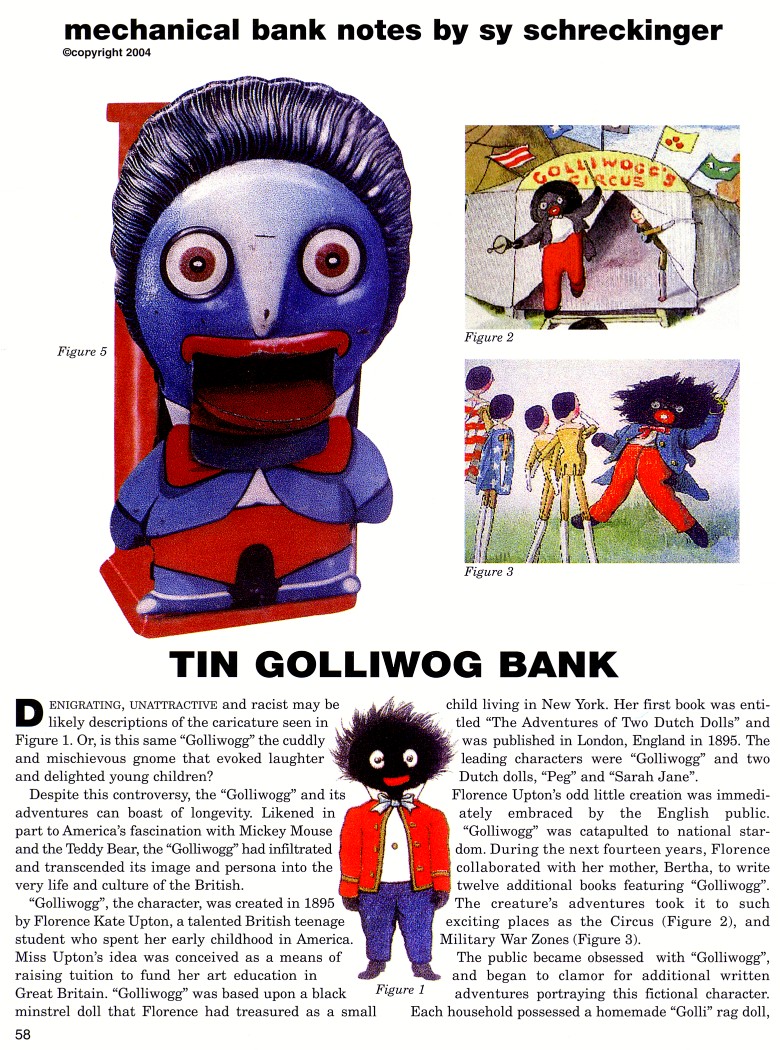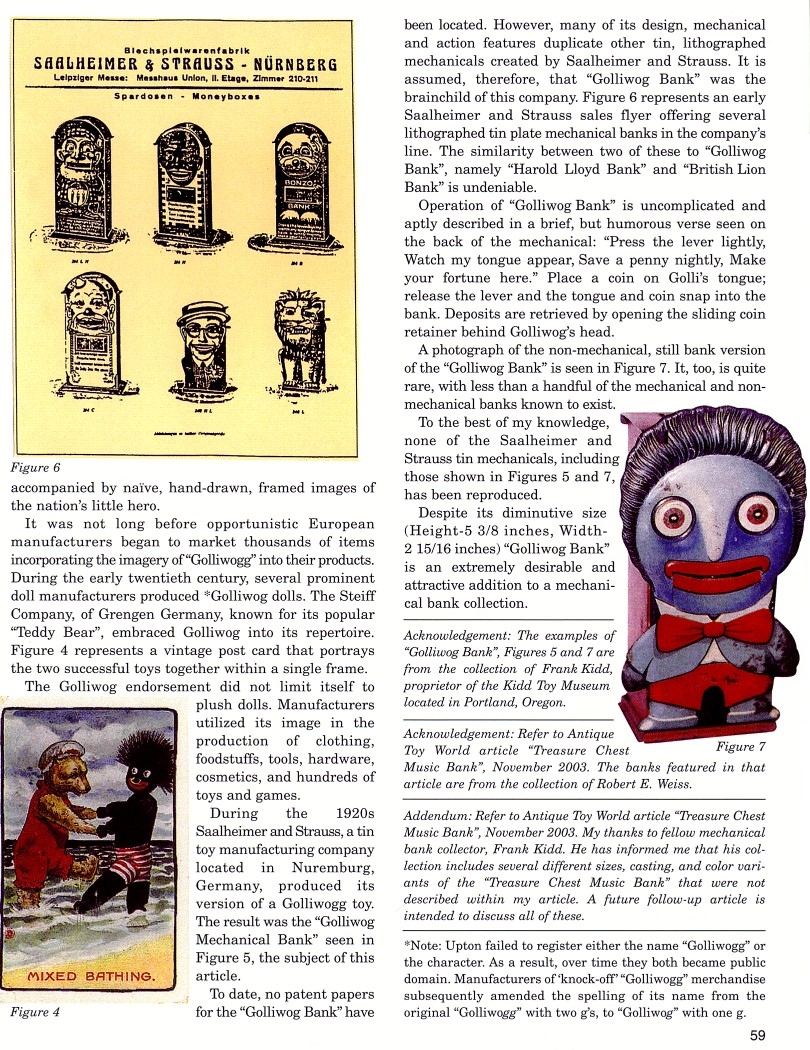|
Tin Golliwog Bank
by Sy Schreckinger – ANTIQUE TOY WORLD Magazine – January, 2004
Denigrating, unattractive and racist may be likely descriptions of
the caricature seen in Figure 1. Or, is this same "Golliwogg" the cuddly
and mischievous gnome that evoked laughter and delighted young children?
Despite this controversy, the "Golliwogg" and its adventures can
boast of longevity. Likened in part to America's fascination with Mickey
Mouse and the Teddy Bear, the "Golliwogg" had infiltrated and transcended
its image and persona into the very life and culture of the British.
"Golliwogg", the character, was created in 1895 by Florence Kate
Upton, a talented British teenage student who spent her early childhood in
America. Miss Upton's idea was conceived as a means of raising tuition to
fund her art education in Great Britain. "Golliwogg" was based upon a
black minstrel doll that Florence had treasured as a small child living in
New York. Her first book was entitled "The Adventures of Two Dutch Dolls"
and was published in London, England in 1895. The leading characters were
"Golliwogg" and two Dutch dolls, "Peg" and "Sarah Jane".
Florence Upton's odd little creation was immediately embraced by the
English public. "Golliwogg" was catapulted to national stardom. During the
next fourteen years, Florence collaborated with her mother, Bertha, to
write twelve additional books featuring "Golliwogg". The creature's
adventures took it to such exciting places as the Circus (Figure 2), and
Military War Zones (Figure 3).
The public became obsessed with "Golliwogg", and began to clamor for
additional written adventures portraying this fictional character. Each
household possessed a homemade "Golli" rag doll, accompanied by naive,
hand-drawn, framed images of the nation's little hero.
It was not long before opportunistic European manufacturers began to
market thousands of items incorporating the imagery of "Golliwogg" into
their products. During the early twentieth century, several prominent doll
manufacturers produced ''Golliwog dolls. The Steiff Company, of Grengen
Germany, known for its popular "Teddy Bear", embraced Golliwog into its
repertoire. Figure 4 represents a vintage post card that portrays the two
successful toys together within a single frame.
The Golliwog endorsement did not limit itself to plush dolls.
Manufacturers utilized its image in the production of clothing,
foodstuffs, tools, hardware, cosmetics, and hundreds of toys and games.
During the 1920s Saalheimer and Strauss, a tin toy manufacturing
company located in Nuremburg, Germany, produced its version of a Golliwogg
toy. The result was the "Golliwog Mechanical Bank" seen in Figure 5, the
subject of this article.
To date, no patent papers for the "Golliwog Bank" have been located.
However, many of its design, mechanical and action features duplicate
other tin, lithographed mechanicals created by Saalheimer and Strauss. It
is assumed, therefore, that "Golliwog Bank" was the brainchild of this
company. Figure 6 represents an early Saalheimer and Strauss sales flyer
offering several lithographed tin plate mechanical banks in the company's
line. The similarity between two of these to "Golliwog Bank", namely
"Harold Lloyd Bank" and "British Lion Bank" is undeniable.
Operation of "Golliwog Bank" is uncomplicated and aptly described in
a brief, but humorous verse seen on the back of the mechanical: "Press the
lever lightly, Watch my tongue appear, Save a penny nightly, Make your
fortune here." Place a coin on Golli's tongue; release the lever and the
tongue and coin snap into the bank. Deposits are retrieved by opening the
sliding coin retainer behind Golliwog's head.
A photograph of the non-mechanical, still bank version of the
"Golliwog Bank" is seen in Figure 7. It, too, is quite rare, with less
than a handful of the mechanical and non-mechanical banks known to exist.
To the best of my knowledge, none of the Saalheimer and Strauss tin
mechanicals, including those shown in Figures 5 and 7, has been
reproduced.
Despite its diminutive size (Height: 5-3/8 inches, Width: 2-15/16
inches) "Golliwog Bank" is an extremely desirable and attractive addition
to a mechanical bank collection.
Acknowledgement: The examples of "Golliwog Bank", Figures 5 and 7 are
from the collection of Frank Kidd, proprietor of the Kidd Toy Museum
located in Portland, Oregon.
Acknowledgement: Refer to Antique Toy World article "Treasure
Chest Figure 7 Music Bank",
November 2003. The banks featured in that
article are from the collection of Robert E. Weiss.
Addendum: Refer to Antique Toy World article "Treasure Chest
Music Bank", November 2003. My thanks to fellow mechanical bank collector,
Frank Kidd. He has informed me that his collection includes several
different sizes, casting, and color variants of the "Treasure Chest Music
Bank" that were not described within my article. A future follow-up
article is intended to discuss all of these.
*Note: Upton failed to register either the name "Golliwogg" or the
character. As a result, over time they both became public domain.
Manufacturers of 'knock-off' "Golliwogg" merchandise subsequently amended
the spelling of its name from the original "Golliwogg" with two g's, to
"Golliwog" with one g.
|

